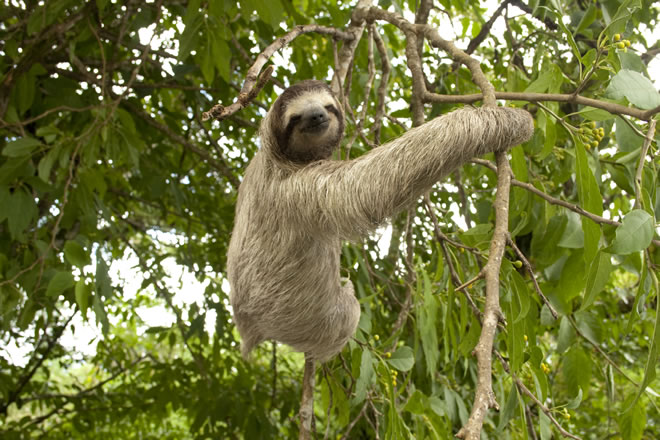This is a great article on the research that they are doing on the sloths here in Latin America including Panama.
Speed read
- Fungi in sloth hair produce compounds that attack bacteria and cancer cells
- They also work against the parasites that cause malaria and Chagas’ disease
- Further useful compounds could be collected from other sloth species
Sloths may be slow, apparently boring animals, but their hair is fast becoming an intriguing avenue for scientists seeking new drugs, including antibiotics and cancer-fighting compounds.
A paper published in PLOS One this month (15 January) shows that sloth hair harbours a rich diversity of fungi whose extracts may contain a treasure trove of compounds active against bacteria, breast cancer cells and the parasites that cause malaria and Chagas’ disease.
The study looked at what was hiding in the outer hair of three-toed sloths (Bradypus variegatus), tree-dwelling mammals found in Panama’s lowland forests, collected from Soberanía National Park. It identified diverse species of fungi some of them potentially new, and went on to test 84 extracts from those fungi for their activity against disease-causing microbes and cells.
Sarah Higginbotham, lead author and a microbiologist at the Smithsonian Tropical Research Institute in Panama at the time of the study, says she got inspired when she first learnt that sloth fur was home to green algae and absorbed water like a sponge, making it an ideal environment for micro-organisms.
“It got me wondering what else the fur might be home to,” she says.
Her curiosity paid off when the study revealed that several extracts were highly bioactive in the laboratory, which was defined as at least halving the growth rate of parasites and cancer cells.
Two of the extracts were highly active against Plasmodium falciparum, the parasite that causes malaria, eight against Trypanosoma cruzi, which is responsible for Chagas’ disease, and 15 against human breast cancer cells.
The activity against T. cruzi is especially interesting, the authors say, since current treatment for Chagas’ disease is limited to only two compounds with such toxic side effects that therapy is often abandoned.
“These results help the lay public understand the value of wild animals and that they are an integral and necessary part of ecosystem life.”
Gileno Xavier, Rural Federal University of Pernambuco
The researchers found 20 extracts to be active against bacteria, with five of them especially promising in terms of bioactivity and one effective against Gram-negative bacteria that are usually more resistant to antibiotics. The findings also suggest the compound may kill bacteria in a novel way, the authors write.
This is highly valuable and worth pursuing further, they say, because infections caused by multidrug-resistant Gram-negative bacteria, are on the rise and few antibacterial agents that target these microorganisms are under development.
Gileno Xavier, a specialist on the B. variegatus sloth from the Rural Federal University of Pernambuco, in Brazil, says the study highlights the importance of conservation efforts.
“These results help the lay public understand the value of wild animals and that they are an integral and necessary part of ecosystem life”, says Xavier.
Xavier says there should be more investment in bioprospecting: searching for useful compounds in nature.
“Considering the Brazilian animal diversity, for example, there is a wide potential for studies like these”, says Xavier.
The researchers now plan to purify the bioactive compounds from the fungi and investigate their structures to determine if they are new and chemically interesting.
“The pressing need for new medications continues to represent one of humanity’s greatest challenges,” they write, adding that the “vast majority of bioactive microbes remain to be discovered”.
They expect that other new microbes “could be found on sloth hair by expanding survey methods” and by sampling sloths in other parts of Latin America. “Thus our work suggests that fruitful exploration of the sloth microbiota is warranted for potential applications in drug discovery.”
